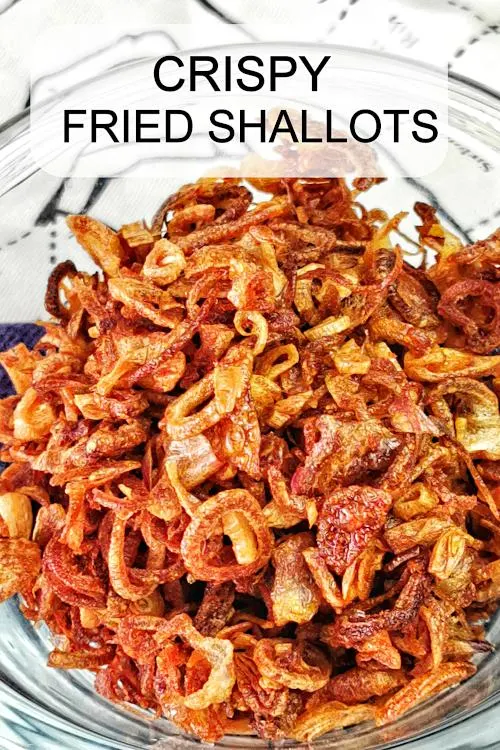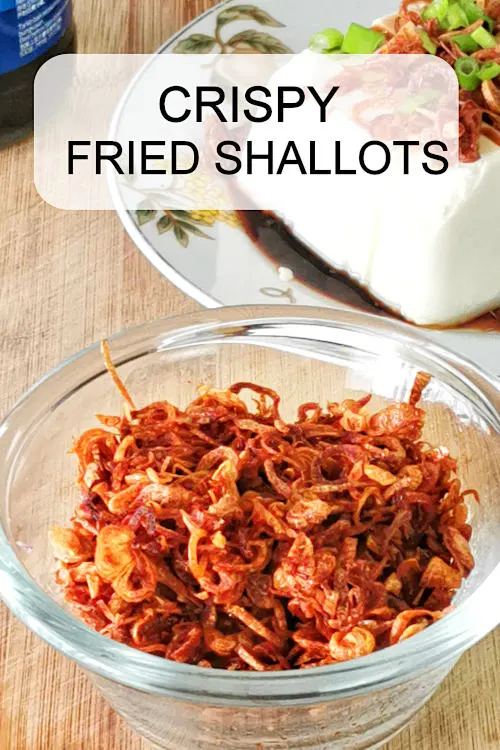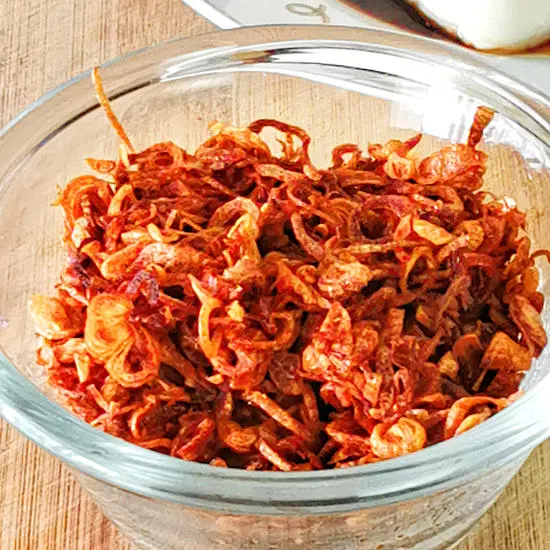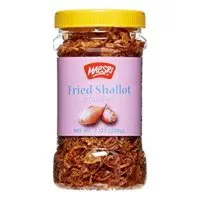Crispy fried shallots are a must-have condiment in most Asian families. It adds crispness, aroma, and flavor to almost every dish, ranging from Ipoh shredded chicken noodles, fried noodles, fried rice, and congee. Although fried shallots are sold at most Asian grocery stores, it is easy to make them yourself. Below is my recipe for preparing crispy fried shallots at home and the accompanied shallot oil.
Note: This post may contain affiliate links. Please read my privacy policy for more info. I may receive commissions for purchases made through links in this post. As an Amazon Associate, I earn from qualifying purchases.
How to make crispy fried shallots
Crispy fried shallots are available at your nearby Asian grocery store, but it is effortless to make them at home. Here is the step-by-step guide on how to make fried crispy shallots.

Preparation
- First, you need shallots, not large onions, for this recipe. I chose the Thai shallots about 2 cm in diameter for this recipe.
- After purchasing the shallots, cut off both ends and remove the skin.
- Cut the shallots crosswise in rings, either with a mandoline or a sharp knife. It is important to slice the shallots into equal thickness to produce a crispy texture.
- Loosen up the rings to maximize the surface contact with the oil during frying, as this step helps to make it even more crispy.
Deep-frying
- Now heat some vegetable oil into a medium size sauce pan. I prefer using peanut oil, palm oil, sunflower oil and canola oil which have a neutral flavor. This oil has a high smoking point suitable for frying the shallots until crispy at high heat. On the other hand, olive oil is not suitable to make Asian-style fried shallots since it does not have a neutral flavor, as we do not want the flavor of the oil to compete with the aroma and flavor of the shallots.
- Once the oil is heated to medium, place the shallot slices into the hot oil. Make sure there is enough oil to submerge them for even frying. Keep the temperature at medium heat and let it sizzle slowly.
- Constant stirring with a pair of chopsticks to separate the shallot rings helps fry them evenly.
- The process will take a while, which depends on how much the shallot is and the temperature of the oil. The endpoint is when the shallot has become golden brown.
- You have to be patient to achieve this color, as the coloring of the shallot will darken fast when it is about to be ready. Therefore, I suggest reducing the heat to low and stirring regularly when the shallots change color.
- Once the color has turned golden, please remove it from the oil immediately with a slotted spoon. The golden shallots will turn slightly darker after removing oil due to the carryover heat. So please consider this happening to decide when you want to remove the shallots from the oil to prevent them from getting too dark and turning bitter.
- When the fried shallots have returned to room temperature, blot the shallots with paper towels, then keep them in an airtight container.
Note:
- This fried shallots recipe does not include salt or chili peppers while frying the shallots since it is not meant to eat on its own. Therefore, the saltiness will be adjusted when serving it with noodle soups, fried noodles, or rice.
- We also do not coat the shallot rings with cornstarch. The shallot will crisp up without the need for cornstarch.

The shallot oil
This crispy fried shallot recipe also yields a by-product, the aromatic fried shallot oil. (葱头油). Since the oil is infused with the wonderful flavor of shallots, it is a stand-alone multi-usage item in the kitchen. For example, you can use it to flavor any noodles, make salad dressings, vinaigrettes and mayonnaise.
How to use fried shallots and shallot oil
You can use the Asian-style fried shallots instead of the French fried onion to prepare green bean casserole. Otherwise, the fried shallots are best to sprinkle over noodles, tofu, porridge, and stir-fried dishes.
Storage
Store the crispy shallots in an airtight container at room temperature. It can be kept for a few months and still crispy.
Alternatively, you can leave the crispy fried shallot suspended in the oil. That is how we keep them at home, as the oil will keep them crispy as long as the oil fully covers them. This image is our homemade crispy shallots suspended in oil.
Crispy fried shallots recipe

Crispy fried shallots are a must-have condiment in most Asian families. Below is my recipe for preparing crispy fried shallots at home and the accompanied shallot oil.
Ingredients
- 130g Thai shallots
- Sufficient oil to submerge the shallot for deep-frying
Instructions
- Cut off both ends of the shallots and remove the skin.
- Cut the shallots crosswise in rings, either with a mandoline or a sharp knife.
- Now heat some vegetable oil in a medium saucepan or pan.
- Once the oil is heated to medium, place the shallot slices into the hot oil.
- Constant stirring with a pair of chopsticks to separate the shallot rings helps fry them evenly. The endpoint is when the shallot has become golden brown.
- Once the color has turned golden, please remove it from the oil immediately with a slotted spoon.
Recommended Products
As an Amazon Associate and member of other affiliate programs, I earn from qualifying purchases.
-
 Pre-Seasshioned Cast Iron Skillet 2-Piece Set (10-Inch and 12-Inch) Oven Safe Cookware - 2 Heat-Resistant Holders - Indoor and Outdoor Use - Grill, Stovetop, Induction Safe
Pre-Seasshioned Cast Iron Skillet 2-Piece Set (10-Inch and 12-Inch) Oven Safe Cookware - 2 Heat-Resistant Holders - Indoor and Outdoor Use - Grill, Stovetop, Induction Safe -
 Mueller Multi Blade Adjustable Mandoline Cheese/Vegetable Slicer, Cutter, Shredder with Precise Maximum Adjustability
Mueller Multi Blade Adjustable Mandoline Cheese/Vegetable Slicer, Cutter, Shredder with Precise Maximum Adjustability -
 Maesri Fried Shallot, 7 Ounce
Maesri Fried Shallot, 7 Ounce
Nutrition Information:
Yield:
1Serving Size:
1Amount Per Serving: Calories: 248Total Fat: 14gSaturated Fat: 1gTrans Fat: 0gUnsaturated Fat: 13gCholesterol: 0mgSodium: 21mgCarbohydrates: 29gFiber: 6gSugar: 14gProtein: 4g
This data was provided and calculated by Nutritionix on 3/13/2022

Stewart
Sunday 13th of March 2022
Why wash after removing protective skin??? Makes no sense.
KP Kwan
Saturday 12th of March 2022
Hi, this is KP Kwan. I am happy to see you in this comment area, as you have read through my recipe. I am glad to reply to any questions and comments as soon as possible.